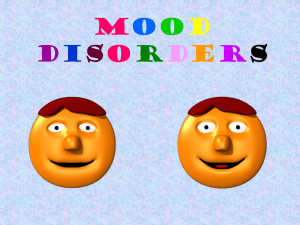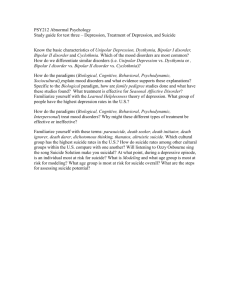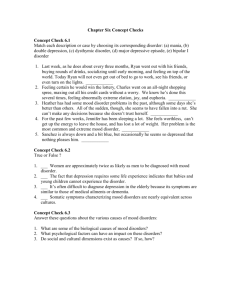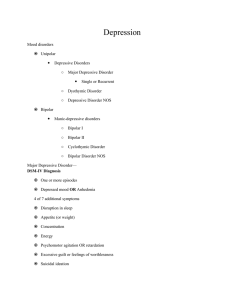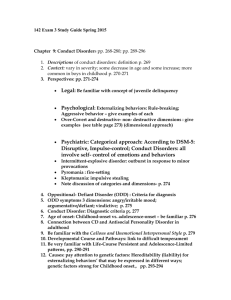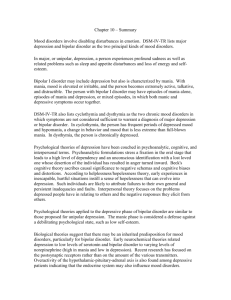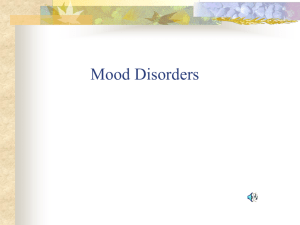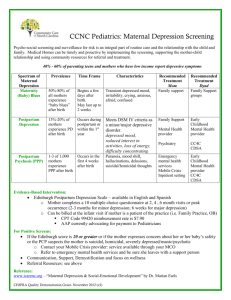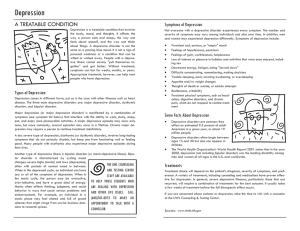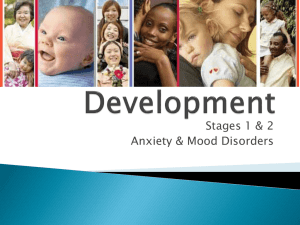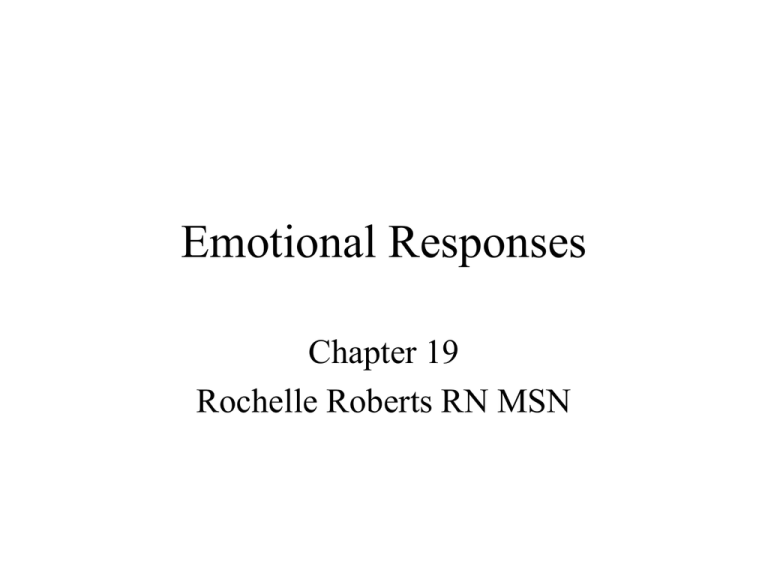
Emotional Responses
Chapter 19
Rochelle Roberts RN MSN
Mood
• A feeling state
• An emotion
Adaptive functions of emotions
•
•
•
•
Social communication
Physiological arousal
Subjective awareness
Psychodynamic
defense
Adaptive emotional responses
• Implies an openness
and awareness of
feelings
• An example is an
uncomplicated grief
reaction
Maladaptive emotional responses
• A detachment or
denial of one’s
feelings
• Suppression of
emotions and a
delayed grief reaction
are examples of a
maladaptive response
• Mania and depression
are other examples.
Grief
• Is the subjective state that follows loss
• Two types of pathological grief reactions
are:
• delayed grief reaction and distorted grief
reaction (depression)
Lifetime Risk for Depression
• For women 20-30%
risk
• For men 7-12% risk
• Depression often
occurs along with
other medical and
psychiatric illnesses
Bipolar Disorders
• A depressive episode
with previous or
current manic
episodes.
• Mania is an elevated
or irritable mood.
Depression
• Behaviors may vary.
• Key element here is change in assessing
behavior
• A change in usual behavior patterns
• The most common behaviors are depressive
mood, anxiety, and somatic complaints.
Risk Factors for depression
•
•
•
•
•
•
•
•
Prior episodes of depression
Fhx
Prior suicidal attempts
Female gender
Age at onset < 40 years old
Medical comorbidity
Personal hx of sexual abuse
Substance abuse
Postpartum blues
• Are brief episodes lasting
1-4 days that occur in 5080 % of women within 1-5
days of delivery.
• Postpartum depression
occurs from 2-12 months
after delivery, risk is 1015%.
• Postpartum psychosislow incidence, onset 2-3
days post delivery.
Seasonal Affective Disorder
(SAD)
• Depression that comes with shortened hours
of daylight in winter and fall and disappears
during spring and summer.
Potential for suicide
• 15% of severely
depressed patients
commit suicide
• 25-50% of patients
with bipolar disorder
attempt suicide at least
once.
Predisposing Factors of depression
• Genetics in the case of recurrent depression and bipolar
disorder.
• Aggression turned inward theory (Freud)-anger turned
inward
• Object loss theory -ruptured tie between mother and child
• Personality organization theory- poor self-concept
• cognitive model-related to disturbed thinking
• Helplessness/hopelessness model- no control over
outcomes in life
• Behavioral model- person affects environment with
reinforcement variable
Biological Model
• Mood disorders result from dysregulation
in neurotransmitter systems, particularly
serotonin. (5-HT)
• And from mechanisms that control
hormonal balance (cortisol, GH, and
prolactin) and biological rhythms.
Precipitating stressors and mood
disorders
•
•
•
•
Loss of attachment (death)
Life events ( physical and sexual abuse)
Role strain (gender related work& home)
Physiological changes (meds and illnesses)
Coping Mechanisms
• Mourning and bereavement; Mourning
begins with introjection-directing your
feelings toward the mental image of a loved
one. This serves as a buffering mechanism.
NANDA Diagnoses
•
•
•
•
•
•
Dysfunctional grieving
Hopelessness
Powerlessness
Spiritual distress
Risk for suicide
Risk for self directed violence
DSM-IV-TR diagnoses
•
•
•
•
Bipolar disorders
Cyclothymic disorders
Major depressive disorder
Disthymic disorder
Nursing outcome
• Patient will be emotionally responsive and
return to a pre-illness level of functioning
Planning care
• Reduction and
removal of
maladaptive emotional
responses
• Restoration of the
patient’s occupational
and psychosocial
functioning
Planning care cont.
• Improvement in the patient’s quality of life
• Minimization of the likelihood of relapse
and recurrence
3 Phases of Treatment
• Acute treatment- goal is to eliminate
symptoms (6-12 weeks)
• Continuation treatment- goal is to prevent
relapse ( the return of symptoms) and to
promote recovery (4-9 months)
• Maintenance treatment-goal is to prevent
recurrence- a new episode of illness (1 or
more years)
Nursing Interventions address:
• Environmental issues- highest priority should be
given to the potential for suicide.
• Nurse-patient issues-supportive companionship
• Physiological treatments-(meds, ECT,sleep
deprivation, & phototherapy)
• Expressing feelings-encourage expression of hope
• Cognitive strategies-help patient explore their
feelings, increase positive thinking by reviewing
strengths.
Nursing Interventions address:
• Behavioral changes- give reinforcement to
accomplishing positive activities, occupational and
recreational activities. Also encourage movement
and physical exercise.
• Social skills model effective social behaviors to
increase self-esteem
• Mental health education for patient and the family
to increase family functioning and decrease
symptomatology.
Mental Health Education cont.
• Communicate that mood disorders are a
medical illness, not a character defect
• Recovery is the rule, not the exception
• Mood disorders are treatable illnesses
• Goal of intervention is not just to get better,
but to get and stay completely well.

